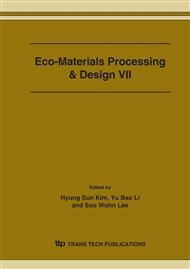p.702
p.706
p.710
p.714
p.718
p.722
p.726
p.730
p.734
Surface Characteristics of the Engineered Polymeric Media for Filtration and Adsorption in Urban Runoff
Abstract:
Urban runoff is one of the major sources that contaminates water supplies because it contains toxic compounds such as heavy metals and PAHs (poly aromatic hydrocarbons) as well as suspended solids, organic compounds, and nutrients. The eingineered polymetric media in this research were developed as filtering media in the storm water treatment equipment. The media used in this study can remove contaminants in urban runoff via adsorption and filtration. The engineered media composed of polypropylene and anion surfactant were foamed to have buoyacy and then shattered by mechanical device for efficient filtration. Surface characteristics of the engineered media were determined by using a scanning electron microscope and a microscope. Results indicated that surface area of the engineered media were increased from less than 0.05m2/g for the neither foamed nor shattered media to 7.82m2/g for the foamed and shattered media. Specific gravity of the media that were foamed and shattered was 0.108~0.154 whereas the non-treated media had specific gravity of 0.914. Fractal dimension of media was measured for the irregularity of the media shape and the media that had high fractal dimension value was performed high filtration efficiency of suspended solids in runoff.
Info:
Periodical:
Pages:
718-721
Citation:
Online since:
March 2006
Authors:
Keywords:
Price:
Сopyright:
© 2006 Trans Tech Publications Ltd. All Rights Reserved
Share:
Citation:


